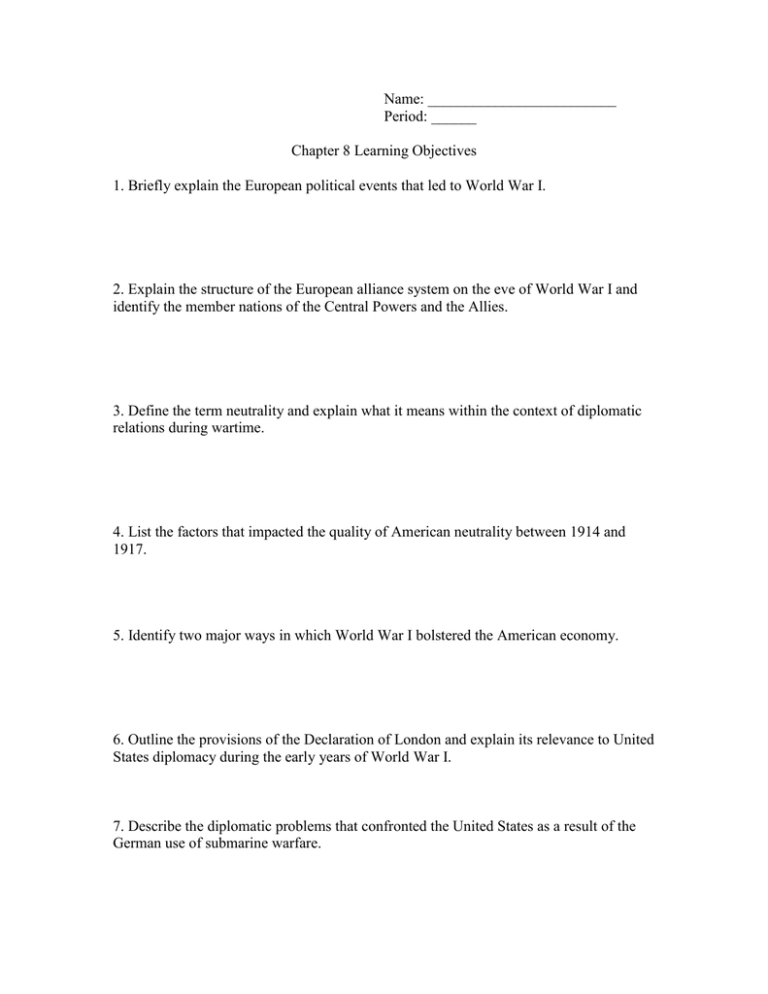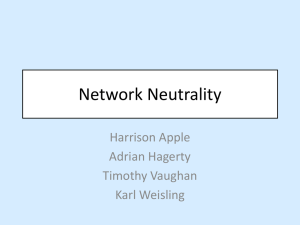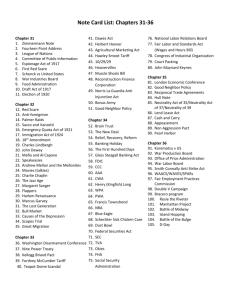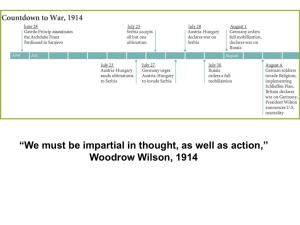Document 15613332
advertisement

Name: _________________________ Period: ______ Chapter 8 Learning Objectives 1. Briefly explain the European political events that led to World War I. 2. Explain the structure of the European alliance system on the eve of World War I and identify the member nations of the Central Powers and the Allies. 3. Define the term neutrality and explain what it means within the context of diplomatic relations during wartime. 4. List the factors that impacted the quality of American neutrality between 1914 and 1917. 5. Identify two major ways in which World War I bolstered the American economy. 6. Outline the provisions of the Declaration of London and explain its relevance to United States diplomacy during the early years of World War I. 7. Describe the diplomatic problems that confronted the United States as a result of the German use of submarine warfare. 8. Discuss the American debate over the neutrality in 1915. Identify the event that escalated debate over neutrality. Identify William Jennings Bryan and explain the significance of his role in the debate. Outline the provisions of the Gore-McLemore Bill and the Sussex Pledge and explain their connections to the debate over neutrality. 9. Explain the intent of the preparedness program. Distinguish between the beliefs of those who supported preparedness and those who did not. 10. Identify the issues and events occurring in fall 1916 and spring 1917 that finally culminated in the American entry into World War I. 11. Describe the Wilson administration’s organization of the wartime economy and list the major government boards responsible for the economy during World War I. 12. Explain the impact of World War I on the lives of women and African Americans. 13. Explain the role of the Committee on Public Information during the war. 14. Identify two Congressional laws designed to suppress dissent against the American involvement in World War I. Discuss how federal efforts to suppress dissent impacted radical groups in America. Identify other means of suppression used by state and local governments as well as private groups. Discuss the connection between national concerns about loyalty and the treatment of labor unions during World War I. Name: _________________________ Period: ______ Chapter 8 Learning Objectives 15. Describe the provisions of the Selective Service Act and describe life in the United States military training camps. 16. Outline the provisions of the Fourteen Points and describe the diplomatic philosophy Wilson brought to the Paris Peace Conference. 17. Identify the major players at the Paris Peace Conference. 18. Discuss the political divisions within Congress regarding the ratification of the Treaty of Versailles. Distinguish between the Irreconcilables and the Reservationists. Briefly discuss the issues that led to the failure to ratify the treaty. 19. Briefly discuss the economic and social impact that the war’s end had on women, African Americans, labor unions, and radicals. 20. Define the term Red Scare and identify the factors that led to the emergence of American fear of Communism after World War I.


